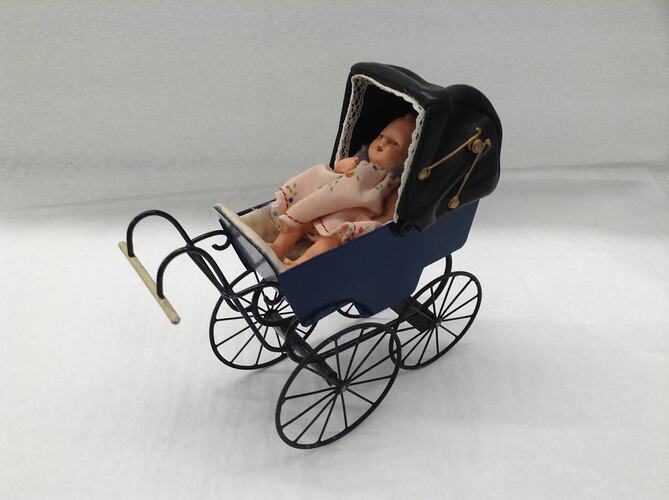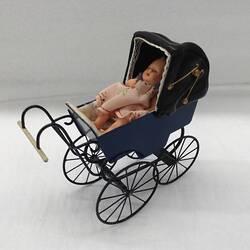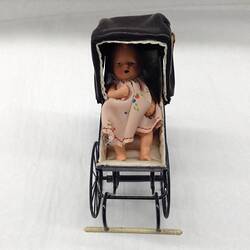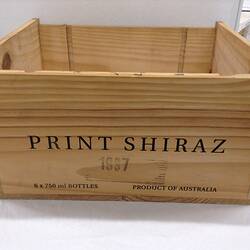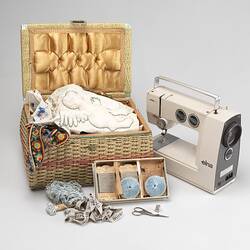Summary
Miniature black metal and cloth pram containing a tiny pink plastic baby doll which was owned and used by Mirka Mora in her art studio in Tanner Street Richmond from the year 2000. Mirka located there after having lived in a number of residences and studios in Melbourne CBD, Toorak, and St Kilda. These items were part of a group of small dolls, prams and furniture stored in a timber wine box (HT 55702).
This is one of a collection of artist's materials, sewing equipment, clothing and personal items relating to the life and work of iconic Melbourne artist Mirka Mora, sourced from her Richmond artist studio in 2019.
The collection of miniature dolls, prams and furniture reflect Mirka's preoccupation with childhood (partly due to her own childhood lost to World War II). She would play with her large doll collection. It was part of her performative practice as she created miniature worlds which inspired her artwork. She reflects in her book 'Love and Clutter': 'The dolls of my childhood were light as a feather and fragile. Some had handpainted eyes, some had flirting eyes, but mostly they captured the essence of a baby's body shape, no matter what size they were. The dolls had been bought naked and it was lovely to dress them, to knit or crochet clothes for them, then put them in little cradles or toy prams. It is good to recapture blissful moments of your childhood. ('Love and Clutter', 2003, p.49)
Physical Description
Painted black metal miniature pram with white handle and black leather hood. Interior is lined with white padded satin. The pram originally contained a small doll wearing a pink floral dress. The doll has an open mouth and movable arms to suck her thumb. The doll has pale pink skin and painted hair.
Significance
Statement of Historical Significance:
There are few names as synonymous with Melbourne's cultural and artistic life as Mirka Mora. Artist and café and restaurant owner, her larger than life personality and her very accessible and public art dominated Melbourne's cultural landscape for over 50 years. Mirka was a post World War II migrant and a leader in the formative years of Melbourne artistic and cultural urban development. Mirka embodied the spirit of bohemian Melbourne for decades and this diverse collection provides an entry point to appreciating the rich life of a complex, multi-faceted woman. The material represents a migrant, cultural and artistic life, revealing her artistic processes, influences and style,and brings the personal side of Mirka to life.
This collection also complements one of the migration collection's strongest sub-collections, the Immigration and Artistic Practice collection. This collection draws on artworks, materials, equipment, migration objects and oral histories to explore how Victorian migrant artist's adapt, develop and transform their artistic practice within a new social, cultural and artistic environment. It provides evidence of the richness provided to the documenting of migrant artist's lives, not just through their artworks, but through the materials showing how their practice evolved over time.
More Information
-
Collecting Areas
Migration & Cultural Diversity, Working Life & Trades, Clothing & Textiles, Childhood
-
Original Owner
-
Classification
Migration, Settlement - cultural & social life, Tools & equipment
-
Category
-
Discipline
-
Type of item
-
Overall Dimensions
48 mm (Width), 128 mm (Depth), 112 mm (Height)
-
Keywords
Artists, Art, Painting Equipment, Sewing Baskets, Sewing, Dolls
